
The definition of life is a huge unanswered question. It is obvious that microbes and multicellular organisms are alive. But when discussing viruses, and prions, the definition becomes vague and inaccurate.
Life is often defined as a comparison between animate and inanimate objects. Inanimate objects include rocks and minerals. But, a kink in this definition is that molecules from rocks and minerals play a major role in life processes. Animate objects have self-sustaining processes and homeostasis, a technical word referring to an organism maintaining a constant internal state. These life-defining processes include reproduction, metabolism, adaptation, capacity to grow, and response to stimuli. Another definition of life emphasizes the importance of signaling and communication. Inanimate objects sometimes display some of these characteristics.
In fact, with the new scientific disciplines of synthetic life (making cells from inanimate chemicals), nano-robotics, and bionic neuroprosthetics the distinction between the living and non living is getting even fuzzier.
 Cells are often considered the basis of life because they clearly are alive and are the smallest units that include all of these characteristics of life described above. The first cells appeared on the earth about 3.7 billion years ago, not long after the earth became habitable. It is not at all clear what came before these cells, but some think that RNA molecules became self replicating and eventually formed cells. Were these RNA molecules alive?
Cells are often considered the basis of life because they clearly are alive and are the smallest units that include all of these characteristics of life described above. The first cells appeared on the earth about 3.7 billion years ago, not long after the earth became habitable. It is not at all clear what came before these cells, but some think that RNA molecules became self replicating and eventually formed cells. Were these RNA molecules alive?
Previous posts have shown that some cells such as the neurons are vastly more complex than others, and appear in some ways to be a civilization of living parts. Are the parts of the neuron, such as apparently independently functioning organelles, also alive? In a previous post it was considered whether mitochondria in the neuron are still functioning as living microbes within the cell.
A previous post discussed the question of whether individual cells that exhibit decision-making, communication and group activity are not only alive but also sentient. The question must now be asked about viruses.
Remarkable Viruses

Viruses are quite remarkable and perform many functions that make it hard to believe they are inanimate. It is not widely known that they are one of two dominant life forms on the earth, the other being microbes, not humans. In fact the phage virus, which attacks bacteria, is the most prevalent life form on Earth. Just in the ocean there are 1030 viruses at any moment. The post on the order of magnitudes in the universe demonstrates that a power of thirty zeros is the same ratio comparing a human being to the entire universe. The mass of the viruses in the ocean would equal 75 million blue whales, and the size of all viruses end to end would equal sixty galaxies. (See Zimmer in Resources )
Viruses can invade cells ten trillion times a second. Importantly, viruses kill half of all bacteria in the oceans each day, which creates considerable organic material that floats to the bottom of the ocean (one billion tons of carbon each day). In fact, the White Cliffs of Dover are made up of dead microbes killed by viruses. These enormous changes in life each day have significant effects on the carbon and oxygen in the earth’s atmosphere.
Entering the cell

A virus is made up of two parts: a genetic core of DNA or RNA called the virion, and a capsule of protein and lipids called the capsid (the combined structure is also called nucleocapsid). To continue producing new viruses they must enter into cells and hijack the mechanisms the cells use to copy, transcribe and translate DNA and RNA.
Viruses enter their victim cells through many different complex mechanisms. The cell being attacked must cooperate extensively with the virus for it to enter the cell. Attacking animal cells, with complex cell walls, is more elaborate than on bacteria, algae, and plants.
 Viruses have many indentations on their cell wall and these are used to latch onto a cell. Other virus receptors might change the pH causing the cell membrane to alter its shape. Some viruses allow themselves to be enveloped in sacs, or vesicles, that the cells bring inside the cell and use to kill invaders. Once in the cell the virus fuses with the membrane of the sac and bites its way out. Viruses use some of the same mechanisms that were described in the post about neuronal sacs transporting neurotransmitters. The neuronal sac fuses and un-fuses with the membrane at the synapse without making holes. Some other viruses actually punch holes in the membrane.
Viruses have many indentations on their cell wall and these are used to latch onto a cell. Other virus receptors might change the pH causing the cell membrane to alter its shape. Some viruses allow themselves to be enveloped in sacs, or vesicles, that the cells bring inside the cell and use to kill invaders. Once in the cell the virus fuses with the membrane of the sac and bites its way out. Viruses use some of the same mechanisms that were described in the post about neuronal sacs transporting neurotransmitters. The neuronal sac fuses and un-fuses with the membrane at the synapse without making holes. Some other viruses actually punch holes in the membrane.
Travel

Once free inside the cell the virus often sheds its protein capsule. But how does it travel to a place in the victim cell where it can interact with the victim’s genetic material (thereby propagating the virus). In neurons, the virus confronts a terrible maze of barriers along the axon as it travels to the (relatively) faraway nucleus.
To give an idea of scale, a single motor neuron cell extends from the spinal cord all the way to the foot. This distance is millions of times the size of the virus. In human terms, if we consider the axon several inches thick, this distance would be equivalent to the distance from New York to Los Angeles. Another example of this scale is a human being walking along the Wall of China.
Herpes virus, which causes cold sores, chicken pox and shingles, is a good example of complex viral movement inside a neuron. Other viruses such as West Nile, and polio might use the same mechanisms as herpes.
Scientists have typically assumed that to travel viruses’ genetic material diffuses across the cell. Diffusion is the property at work when two soluble substances mix; imagine pouring Kool-Aid mix into water. But this cannot be the method virions travel. The herpes virus, for example, travels 400 times faster than diffusion would predict. Moreover, cells can be crowded with large molecules. Just below the membrane lies a dense scaffolding of actin molecules that supports all the activity of receptors in the membrane. This makes a difficult barrier for virion travel.

A previous post has discussed the fact that mitochondria were once independent microbes and now appear to be dependent symbiotic microbes living inside the neuron with their own movements, reproduction, and self-monitoring for quality. The mitochondria are critical for a neuron’s energy supply, communication with other neurons, and the ability of the cell to destroy itself when necessary. These mitochondria use the microtubule transportation highway to move about the neuron wherever energy is needed rapidly. They move along the entire neuron axon helping the difficult process of long range signaling as well as repair. They also move rapidly to areas where new synapses are being built or disassembled.
A previous post described the marvelous structure of the neuron’s microtubules, perhaps the “brain” of the neuron, which not only build the structure of the neurons’ axons and dendrites on the fly creating new synapses, but also transport molecules long distances. It has been postulated these microtubule also function as quantum computers in their connection with mental activity (see post).
This large microtubule railroad has transport vehicles that travel rapidly along its tracks powered by (protein-based) dynein and kinesin motors. A specific molecule, dynactin, attaches the virion (or full virus) to the dynein motorcar, shuttling it straight to the nucleus. 
Very recently, it has been shown that the herpes virus can control the mitochondria as it would other bacteria. Normally, increased calcium is a signal for the mitochondria to produce energy for the next signal; in addition, the increased calcium is part of the mechanism of its movement. However, when infected with the virus the level of activity in the neuron increases, including an increase in calcium. With an increase in calcium from the virus infection it allows the virus to control the mitochondria.
The viruses disable the mitochondria by unhinging the proteins on which they travel. In particular, they disable the dynein motors. The kinesin motors are then available for the virus. This control of the mitochondria allows the virus to freely travel through the neuron as the mitochondria usually does.
Many Other Herpes Tricks
First of all, the virus must get into a cell. Only then can it hijack a transport system, make it’s way to the nucleus, trick the complex nuclear protection mechanisms, and then highjack the DNA mechanisms. Before it goes into the neuron it first attacks skin cells and multiples there.
To enter the cell, the herpes virus uses the lipid molecules on its surface to bind with the human cells. This process is complex and requires the action of five distinct receptors and the cell membrane. Through this process the virus fuses with the cell membrane, then sheds some of its coat to allow the DNA to enter.
There is yet another complex mechanism attaching what is left of the nucleocapsids (the DNA with some protein) to the nuclear pore (the nuclear pore is a tightly guarded hole which allows molecules to go into and out of the cell nucleus.) After attaching to the nuclear pore the virus DNA is injected into the nucleus. In the nucleus viral DNA forms a circle and activates an even more complex process using the cell’s replication mechanism to make copies of the herpes DNA. Once this is done, molecules are manufactured and more new herpes viruses are created.
These new herpes viruses then leave the skin cells, and enter the neuron, travelling as described on the microtubules to the nucleus. At the nuclear pore of the neuron it again enters the cell’s nucleus.
In the nucleus of the neuron, the virus changes its behavior and produces molecules that stop further production of new viruses. This is done so it will not kill the neuron, and can remain there for years. In this latent stage it can live for many years until it is re-activated.
When the virus is reactivated, it leaves the nucleus and travels on the microtubule motors back along the nerve axon to the skin where it leaves the neuron and again reproduces in skin tissue. It is then that the symptoms of pain and boils appear on the skin.
Viral Intelligence
Recently, viral mechanisms have been found that show a great ability to match wits with some of the most complex mechanisms of cells, as well as serve the function of transferring vital mechanisms to and from cells.
 In particular a study showed that the herpes virus imitates a signaling molecule for DNA repair that destroys the cells’ defense. A previous post showed the very complex actions of cells in self editing and error correction of their own DNA. In the process of error correction a spot on the DNA is marked. One way DNA damage can be marked is by adding a phosphorus molecule to a piece of DNA (a process called phosphorylation.) In this viral mechanism, the virus attracts one of the DNA damage repair molecules by a similar mechanism, and takes over the function of that repair molecule. The cell is then vulnerable to the virus to take over the DNA apparatus. Somehow the virus understands this complex cellular process of DNA repair.
In particular a study showed that the herpes virus imitates a signaling molecule for DNA repair that destroys the cells’ defense. A previous post showed the very complex actions of cells in self editing and error correction of their own DNA. In the process of error correction a spot on the DNA is marked. One way DNA damage can be marked is by adding a phosphorus molecule to a piece of DNA (a process called phosphorylation.) In this viral mechanism, the virus attracts one of the DNA damage repair molecules by a similar mechanism, and takes over the function of that repair molecule. The cell is then vulnerable to the virus to take over the DNA apparatus. Somehow the virus understands this complex cellular process of DNA repair.
Viruses have been noted to be a reservoir of genetic information which they can transfer to bacteria and animal cells. In recent research a significant mechanism of the phage virus has been elucidated and a very similar machinery has been identified in bacteria.

The first research shows that the phage virus attacks bacteria, by grabbing onto a cell with many feet, and then injecting a needle that includes a package of DNA and other material through machinery that resembles a syringe. A series of proteins uncoil to propel the one nanometer needle into the bacteria. When inside the membrane of the cell, the tip detaches and pushes the genes into the bacteria.
A very similar mechanism was recently described as to how the phage creates such a compact form of DNA to inject into the cell. A tailed motor similar to the syringe inserts DNA chromosomes a into highly compacted particle which can be used in the needle insertion to cells.
Further research has found a very similar mechanism in bacteria. The type VI secretion system of bacteria is similar to the phage injection system to transport proteins into adjacent cells. The picture shows the similarities of these two injection mechanisms. It is clear that the virus and bacteria learned this trick from each other.
Battle of The Lifeforms
Viruses are able to keep up a running battle with all other life forms on earth.

The sheer number of different viruses and the speed at which they multiply are so fantastic that they are virtually incomprehensible. In each centimeter of ocean there are countless totally unknown new species. They rapidly mutate and change and therefore function as an enormous library and depository of DNA and RNA of all types.
There is a constant battle between the two most prominent life forces on the planet, viruses and bacteria, which advances at a furious pace. For example, if a single phage virus is added to a culture of 10 billion E.Coli bacteria within two hours there are 10 trillion viruses and only 10 million E. Coli remaining. 99.9% of the E.Coli have been killed.
Cooperation of the Life Forms: Viruses are Indispensable for Microbes and Humans
It is important to note that viruses, as well being detrimental to human life, are a very important part of the positive functioning of microbes and humans. They have played important roles in evolution. The virus is constantly evolving with, by far, 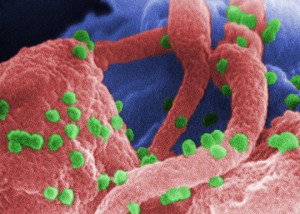 the largest source of genetic information on the planet. Recent research shows that viruses can be key in helping bacteria adapt via “coevolution”. While we do not know the details yet, it is clear that viruses have been a critical part of evolution.
the largest source of genetic information on the planet. Recent research shows that viruses can be key in helping bacteria adapt via “coevolution”. While we do not know the details yet, it is clear that viruses have been a critical part of evolution.
In each human being there are perhaps 10 trillion human cells. There are ten times as many smaller bacterial cells, 100 trillion, inside the human being. Although only ten times as many, in terms of different genes, the bacteria outnumber the human DNA by 360 to 1. Therefore, most of the DNA that a human being uses to function, and to fend off enemy microbe communities is in the bacteria. It is now clear that these trillions of bacteria largely live in harmony with human beings, fend off enemy bacteria, and perform many vital functions for human survival. It is only occasionally that some of these same bacteria are triggered to become enemies.
In the same way, there are vastly more viruses than bacteria in and around human beings, and vastly more variations of DNA and RNA in the viruses than anywhere else. These genes also can be used in the community called a human being.
In the same way that humans need the huge amount of bacterial genes, it is also now being discovered that humans also depend upon the much larger store of viral genes. Many viral genes have been incorporated into the human genome. Of human genes, 8% are from viruses.
A recent finding shows that the very way humans are born is dependent upon a gene from a virus. The cells of the placenta make a protein called syncytin, which is critical to the function of the fetus getting nutrients from its mother. This gene which allows the placenta to exist came from a virus.
Are Viruses Alive and Intelligent?
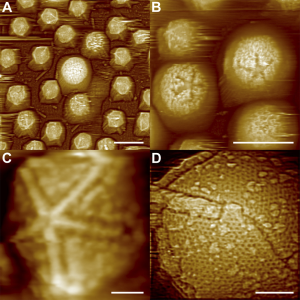
It is hard to think of viruses as inanimate simple objects. They are highly organized and standardized in shape, and function. They need multiple extremely complex mechanisms to survive. Recently, new viruses have been found that push the notion of the definition of life.
The Mimivirus is extremely complex and, like cells, is able to to repair it’s own DNA (see post), correct errors in reproduction, create mRNA and translate these into proteins. It has genes never before described in a virus. A major debate now occurring is whether this virus is a deteriorated cell, or a unique evolutionary organism. A major question is whether viruses are a unique branch of evolution forming a fourth domain since the beginning of evolution.
If viruses are living creatures essential to all of evolution by transmitting information, then it is even harder to define life. Some viruses have a very simple structure, consisting of only a single strand of RNA covered by a protein. These viruses made of only two molecules still have complex functioning. Are these molecules also alive?
Microbes appear to have sentience. Mitochondria, now an organelle inside the neuron, might well have the same sentience.
Viruses appear to have functions, different in nature but comparable in complexity to bacteria. If bacteria have a form of sentience, then can we really say that viruses don’t?

